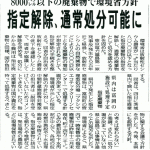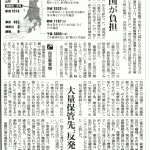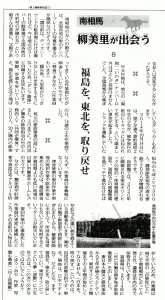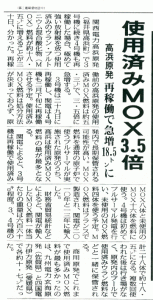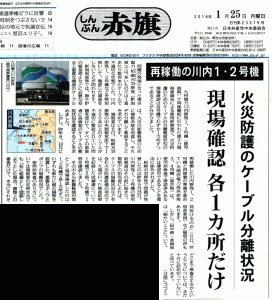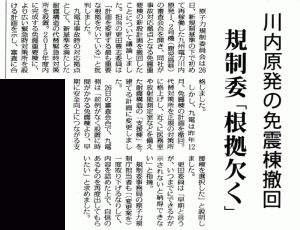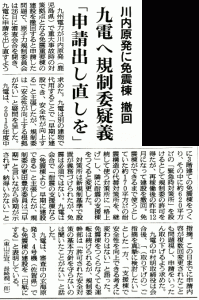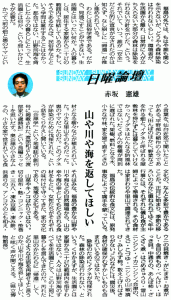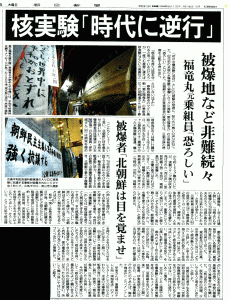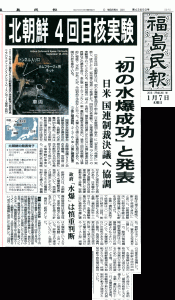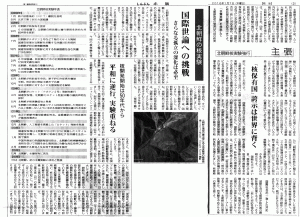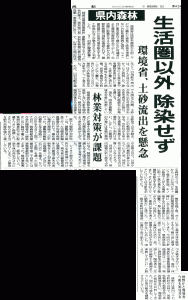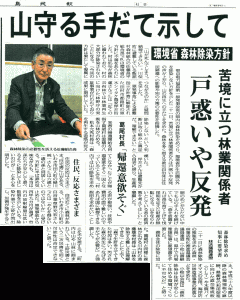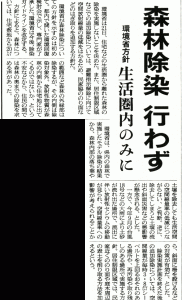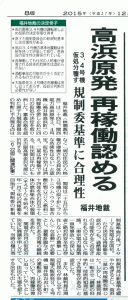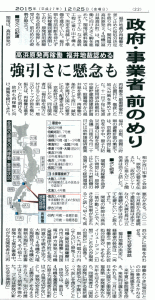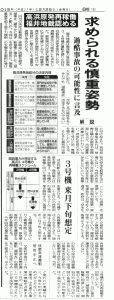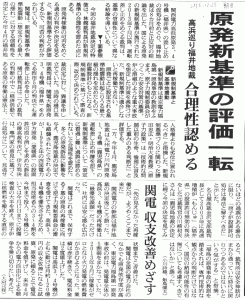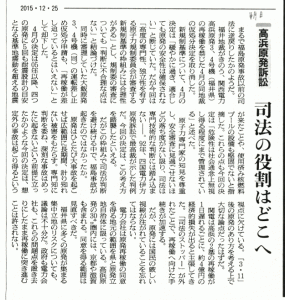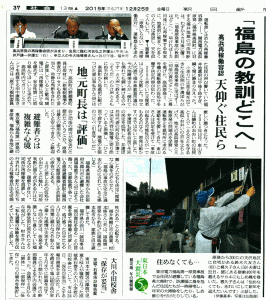Original Japanese written by staffer
The English below translated from the original Japanese by Heeda
The English translation edited by Rev. Dr. Henry French, ELCA
(Based on an article from the February 8th, 2016 edition of the Asahi Shimbun newspapers)
(▼Click the image to enlarge it.)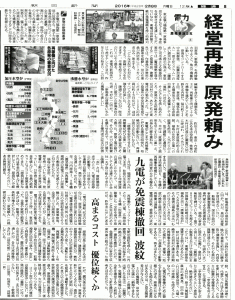
Almost five years have passed since the meltdown began at TEPCO’s Fukushima Daiichi Nuclear Power Plant (NPP). While the disaster and its aftermath are far from over, TEPCO is busy in some areas of Niigata Prefecture, some 150 miles NNW of central Tokyo. Why? The power company is striving to restart its Kashiwazaki-Kariwa NPP, one of the NPPs with the greatest power generation capacity in the world.
— At the central control office of a NPP. Two red lamps turn on, saying “High earthquake acceleration” and “Reactor scram.” “Check it out,” shouts the manager. The NPP’s director issues a state of emergency at the NPP’s emergency office, the center of command in case of an accident. Outside the reactor building, workers are busy starting up emergency power supply equipment. Other workers connect hoses to fire trucks and start pumping water. The workers, nine in number, promise they will “be thoroughly trained to handle whatever situation might arise.” —
This is a description of a TV commercial run by TEPCO only in Niigata. It first went on the air in June 2015, and there are five versions of the commercial, including this “training version.” In short, the commercial claims that the power company is doing everything it can to restart the NPP safely. It goes on air some 240 times every month. This is rather exceptional in that TEPCO has not been releasing TV commercials since the Fukushima Daiichi meltdown in the Kanto Region.
When the commercial began to circulate around Niigata, TEPCO’s employees were going around there as well – in Kashiwazaki City and Kariwa Village, two municipalities hosting the Kashiwazaki Kariwa NPP. “Please take a look at the safety measures we take at the NPP, and rest assured.” Those employees, 115 in number, took four months or so to visit almost every household in the two municipalities, some 40,000 in all.
What makes TEPCO so desperate to restart Kashiwazaki-Kariwa? It is obvious. Without this NPP in operation, the power company is unable to rebuild its business. The company claims that every reactor restarted saves the company spending on fuel and thus helps it improve its balance sheet by some 14 billion yen every month. TEPCO’s business rebuilding plan presupposes restarts of Kashiwazaki-Kariwa’s Units 6 and 7. Thus, the power company is in desperate need for consent to the restarts from the relevant municipalities.
The one holding the key to such local consent is the governor of Niigata Prefecture. The current governor, however, still distrusts TEPCO. His prefectural government has set up a technical (accident investigation) committee of nuclear experts, independent of its counterparts in the national Diet and government. The Niigata committee is investigating the Fukushima meltdown, independently of the national government.
Now, Kashiwazaki-Kariwa, has five boiling water reactors (BWRs), the type installed at Fukushima Daiichi, and two advanced BWRs. Together, the seven can produce more than 8.21 kW of power each hour This is among the largest power generating capacities of NPPs across the world. In case a major accident hits such a gigantic reactor, the resulting hazards would be much worse than those of Fukushima Daiichi.
The governor of Niigata has a pet phrase: “I will never discuss a restart (of Kashiwazaki-Kariwa) unless the Fukushima disaster is fully examined and the examination comes to a conclusion.” In the fall of 2015, TEPCO, responding to a request from the Niigata committee, interviewed its former CEO and some 30 employees relevant to the Fukushima Daiichi meltdown, and reported the results to the committee. Still, the governor has not permitted a restart of Kashiwazaki-Kariwa.
Irritated by the governor’s reluctance to permit a restart, the national government is applying pressure to the prefectural government of Niigata – “permit a restart, or we’ll cut the national subsidy to Niigata.” (For further details on this, please read the article titled “RESTART THE NUCLEAR PLANT, OR —“, dated February 12 on this website.)
This coming fall, Niigata has a governor election. The municipal assemblies of Kashiwazaki and Kariwa already adopted a petition for an early restart of the NPP. So, how will TEPCO’s home-to-home operation affect the election? We will soon find out.
Shortly after the Fukushima Daiichi meltdown, all the NPPs across Japan stopped operating. Though this brought some tension to the power supply, we have been doing without any serious power problem these five years.
With all the ten power companies of Japan combined, the peak power demand in summer 2015 diminished by approximately 13.5% from the summer of 2010, the year before the Fukushima Daiichi meltdown. Many businesses and households learned to save power, while supply increased from new power suppliers. The existing power companies, however, held on to their old NPP-dependent business model.
A NPP brings its operator more profits the longer the plant runs. Though a NPP requires a huge initial investment, its fuel, uranium, is less expensive than fossil fuels. Thus, its running cost is smaller than that of a typical thermal power plant. The three restarted reactors, namely Units 1 and 2 of the Sendai NPP and Unit 3 of Kansai Electric Power’s Takahama NPP (located in Fukui, some 40 miles north of Kyoto), are 30 years old, counting from the year when they first went into operation. The other 26 reactors for which an application for a restart permission has been submitted to the Nuclear Regulatory Authority (NRA) are 25 years old, on the average. These reactors are, in short, at the place where their operators are collecting returns for the initial investments. Those operators hope to make stable profits out of them. Though those operators made more than JPY2 trillion of investments in additional safety measures to their NPPs, they say their NPPs, if restarted, can make up for the 2 trillion yen. However, the NPP regulations established after the 2011 meltdown require more investments in equipment and safety measures than ever before, whether an operator builds a new NPP or extends an existing NPP’s life beyond the basic age for decommissioning, 40 years. Today, the world’s economy is slowing down and the crude oil price is coming down, bringing down the price of liquefied natural gas (LNG) as well. Thus, currently, thermal power is becoming less and less costly and the NPPs’ advantage in lower running costs is only temporary. They could well be money losers for their operators, and those operators have yet to discover what to do if that happens.

